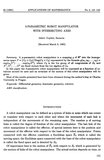Article
Full entry |
 PDF
(1.5 MB)
Feedback
PDF
(1.5 MB)
Feedback
 PDF
(1.5 MB)
Feedback
PDF
(1.5 MB)
Feedback
Keywords:
differential geometry; kinematic geometry; robotics
differential geometry; kinematic geometry; robotics
Summary:
A $p$-parametric robot manipulator is a mapping $g$ of $\mathbb{R}^p$ into the homogeneous space $P=(C_6\times C_6)/\mathop{\rm Diag}(C_6\times C_6)$ represented by the formula $g(u_1,u_2,\dots ,u_p)=\exp (u_1 X^1)\cdot \dots \cdot \exp (u_p X^p)$, where $C_6$ is the Lie group of all congruences of $E_3$ and $X^1,X^2,\dots ,X^p$ are fixed vectors from the Lie algebra of $C_6$. In this paper the $3$-parametric robot manipulator will be expressed as a function of rotations around its axes and an invariant of the motion of this robot manipulator will be given. Most of the results presented here have been obtained during the author’s stay at Charles University in Prague.
References:
[1] A. Karger: Geometry of the motion of robot manipulators. Manuscripta Math. 62 (1988), 115–126. DOI 10.1007/BF01258270 | MR 0958256 | Zbl 0653.53007
[2] A. Karger, J. Nowak: Space kinematics and Lie groups. Gordon and Breach, New York-London, 1985. MR 0801394
[3] A. Karger: Two parametric motions in $E_3$. Apl. mat. 32 (1987), 96–119. MR 0885757
[4] A. Karger: Classification of three parametric special motion with a transitive group of automorphisms and three-parametric robot manipulator. Acta Appl. Math. 18 (1990), 1–16. DOI 10.1007/BF00822203 | MR 1047292
[5] P.G. Ranky, C.Y. Ho: Robot modelling. Springer Verlag, Berlin, 1985.
[6] R. Sulanke: On E. Cartan’s method of moving frames. Proc. Colloq. Differential Geometry, Budapest, 1979.

